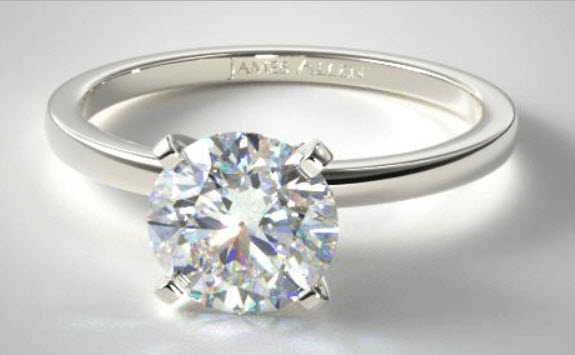You have finally plucked up the courage to ask her the BIG question. Equipped with the parents’ permission, you may now set on the path of choosing the perfect engagement ring replete with a stunning solitaire to dazzle her. However, before you start your endeavour, you may want to go through this list of popular solitaire engagement ring settings to figure out which one she’ll like the best:

- Prong setting
A quintessential design, a prong is a metal claw that holds the solitaire in place. The setting may contain 4 or 6 prongs with a particular cut such as V, round, pointed or flat. With a four prong one, you have more of the diamond being visible, and with the six prongs, you have better security of the solitaire.
- Tiffany setting
Any girl who’s ever seen Breakfast at Tiffany’s and envisioned herself as Audrey Hepburn will love to have such a solitaire gracing her finger! A dreamy modified version of the prong setting, trademarked by Tiffany, this solitaire ring shines brightly as the Tiffany design ensures that the light reflects on the diamond.
- Bezel setting
It’s modern. It’s practical. There can be a partial or complete bezel surrounding the diamond which makes it securely placed.
- Tension setting
The jeweller expertly calibrates the dimensions of the diamond, and tiny grooves are cut into the sides of the band, and the solitaire is held into place with the help of the tension. Additionally, there is a prong or bezel setting that works to secure the solitaire in place.
- Channel setting
When there are smaller diamonds that need to be set into a band, this is the kind of setting that is used. Quite a popular setting for wedding bands, a channel setting has precious stones which are set together in the grooves of the band and grace the entire band.
- Pave setting
In such a setting, the diamonds are set closely together which exudes an appearance of glittery sparkle. The process involves the jeweller drilling tiny holes into the ring, placing the diamonds in the holes using mini-prongs to secure them. Another name for this setting is ‘bead’ setting.
- Halo setting
A beautiful design, it involves placing of gemstones or other precious stones around a central stone. This works well when the centre stone is small, and you wish to focus on the appearance of the central stone. You can also add coloured stones to add character to the ring. Halos can be coupled with pave setting to enhance the look of the ring.
- Bar setting
A unique design, in a bar setting the diamonds, are placed separately between bars which are vertical. This setting can incorporate a centre stone or simply be a standalone ring.
- Vintage setting
Also, called as antique setting, they reflect the Victorian, Edwardian, and Art Deco era. These rings may often include delicate filigree work.
The world of solitaire rings is not limited to these few designs. There are ‘flush’, ‘cluster’, ‘cathedral’ settings too. So, get your research going and find out what your significant other would like!!










Comments are closed.